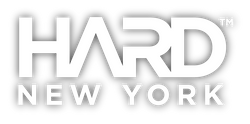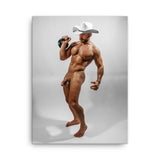Maxwell Alexander’s Cocky Cowboy series is a bold, unapologetic exploration of masculinity, sexuality, and identity that merges the rugged archetype of the cowboy with a candid celebration of queer pride. Set against fine art backdrops, his photographs transcend the boundaries of traditional cowboy imagery by pairing hypermasculine aesthetics with intimate expressions of vulnerability, rebellion, and empowerment.
The Cowboy Archetype Reimagined
The cowboy has long stood as an icon of stoic masculinity, independence, and rugged physicality. In popular culture, he often serves as a symbol of traditional patriarchal ideals—stoic, emotionally restrained, and physically dominant. But in Alexander’s work, the cowboy archetype is turned on its head. His gay cowboy protagonist is confident, sexual, and delightfully subversive.
Clad in nothing but a cowboy hat, a knit sweater, thigh-high socks, and contemporary accessories like ball stretchers, the cowboy in this series becomes an icon of queer liberation. By presenting a character who is unashamed of his body, his sexuality, and his playful embrace of fashion, Alexander dismantles the limiting tropes of masculinity and replaces them with a celebration of authenticity and sex positivity.
Pride in the Body: Sexuality and Rebellion
One of the series' most striking elements is its unfiltered embrace of male sexuality. From the cowboy’s prominent display of his genitals to his playful poses, Alexander leaves nothing to the imagination. Yet, this explicitness is neither vulgar nor gratuitous. Instead, it is a statement: an act of rebellion against the toxic patriarchal systems that police male sexuality, shaming vulnerability and diversity of expression in favor of rigid norms.
The use of accessories, like the ball stretcher, serves as both a physical adornment and a metaphorical statement. These accessories are more than just trendy—they symbolize ownership of one’s sexuality and body, a reclamation of self against the insecurities instilled by patriarchal ideals. Alexander’s cowboy is not just proud of his body; he takes control of it, showcasing it as a tool for pleasure, expression, and freedom.
Masculinity Meets Femininity: The Fluid Spectrum of Identity
Alexander’s work beautifully blends traditionally masculine elements (cowboy hats, knitwear, and the rugged setting) with subtle nods to femininity and gender fluidity. The juxtaposition of a hypermasculine setting with poses that express softness and introspection challenges viewers to reconsider the binary labels so often placed on gender and sexuality.
The cowboy’s unapologetic self-expression—a combination of the rugged and the tender, the masculine and the feminine—rejects the societal expectation that men must choose between being “macho” or “soft.” Instead, the Cocky Cowboy inhabits a liminal space, where masculinity and femininity coexist and thrive. This nuanced representation serves as an empowering message for queer individuals navigating their own identities within a world that too often demands conformity.
A Challenge to the Patriarchy
At its core, the Cocky Cowboy series is a rebellion against the abusive insecurities bred by patriarchal systems. It dismantles the toxic ideal that men must suppress their sexualities, their vulnerabilities, and their desires in order to be considered “real men.” By presenting a cowboy who is at once tender, bold, sexual, and confident, Alexander dares his audience to envision a world where masculinity is not a prison but a playground.
This rebellion is not subtle. Every element in the photos—whether it’s the cowboy’s cheeky poses, his bold accessories, or the playful pride in his own body—serves as a middle finger to the outdated ideals that have constrained men for centuries. The series invites viewers to embrace their own sexualities, celebrate their bodies, and reject the shame imposed by patriarchal norms.
Art That Empowers and Inspires
Maxwell Alexander’s Cocky Cowboy series is more than fine art photography—it’s a call to action. It invites us to reimagine masculinity, challenge societal norms, and celebrate the beauty of authenticity. His cowboy is a figure of pride and liberation, a character who exists at the intersection of sexuality, gender, and identity with fearless joy.
For queer audiences, the series offers representation that is both empowering and affirming. For all viewers, it’s an opportunity to question the restrictive systems of patriarchy and to explore the boundless potential of human expression. Alexander’s work reminds us that there’s nothing sexier, stronger, or more courageous than living—and loving—authentically.
Looking to add a little flair to your room or office? Look no further - this canvas print has a vivid, fade-resistant print that you're bound to fall in love with.
• Artist's signature printed on the right edge of the canvas
• Acid-free, PH-neutral, poly-cotton base
• 20.5 mil (0.5 mm) thick poly-cotton blend canvas
• Canvas fabric weight: 13.9 oz/yd2(470 g/m²)
• Fade-resistant
• Hand-stretched over solid wood stretcher bars
• Matte finish coating
• 1.5″ (3.81 cm) deep
• Mounting brackets included
• Blank product in the EU sourced from Latvia
• Blank product in the US sourced from the US
This product is made especially for you as soon as you place an order, which is why it takes us a bit longer to deliver it to you. Making products on demand instead of in bulk helps reduce overproduction, so thank you for making thoughtful purchasing decisions!
Size guide
| HEIGHT (inches) | WIDTH (inches) | |
| 18″×24″ | 18 | 24 |
| 24″×36″ | 24 | 36 |
🌱 Crafted on Demand, Globally Mindful: Our store actively combats consumerism, overproduction, and landfill waste by producing most of our skincare, fashion accessories, supplements, apparel, and art to order. We utilize fulfillment centers worldwide, manufacturing as close as possible to each consumer to minimize carbon emissions. Our products undergo rigorous manual quality checks, adhering to a strict no-return, no-exchange policy, ensuring a sustainable and eco-conscious shopping experience.




